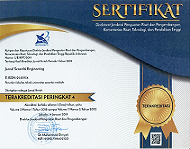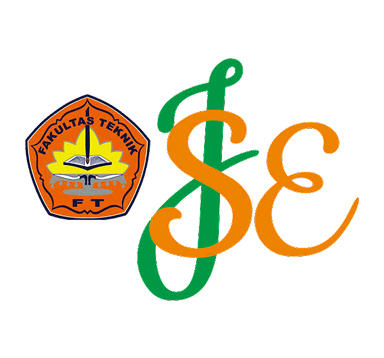Penyisihan BOD Dan TSS Pada Limbah Cair Kafetaria Menggunakan Emergent Macrophyte Wetlands dengan Tanaman Melati Air
Keywords:
BOD, TSS, Limbah Cair Cafetaria , Emergent Macrophyte Wetlands, Melati AirAbstract
The rising trend of working from anywhere has increased activity in cafeterias, which produce wastewater with high levels of organic matter and suspended solids. If discharged without treatment, this wastewater can pollute the environment and disrupt ecosystem balance. This study aims to evaluate the effectiveness of plant quantity and retention time in a constructed wetland system of the sub-surface flow type, using the emergent macrophyte wetland method with amazon sword plant (Echinodorus palaefolius) plants to reduce Biochemical Oxygen Demand (BOD) and Total Suspended Solids (TSS) in cafeteria wastewater. Variations in plant quantity (12, 14, and 16 stems) were tested over a 16-day retention period. The results showed BOD removal efficiency ranging from 94.62% to 97.85%, while TSS reduction ranged from 73.3% to 97.8%, depending on the sampling time. In the best-case scenario (on day 4), the system reduced BOD from 185.9 mg/L to 6 mg/L and TSS from 150 mg/L to 3 mg/L, meeting the effluent quality standards for restaurant wastewater. This high efficiency is attributed to physical filtration through roots and substrate, as well as rhizospheric microbial activity supported by the roots of the Amazon sword plant (Echinodorus palaefolius).
References
[1] P. F. Nurani, L. Nirawati, A. Kriswibowo, and D. Hikmah, “Evaluasi Capaian Implementasi Permenkes No. 1096/ Menkes/ PER/ VI/ 2011 Tentang Jasa Boga Di Kantin Kampus X PROVINSI Jawa Timur,” Экономика Региона, vol. 53, no. 9, pp. 167–169, 2019.
[2] Al Kholif M, “Removal of BOD₅ and COD from Domestic Wastewater by Using a Multi-Media-Layering (MML) System Muhammad,” vol. 66, no. 6, 2023.
[3] N. Hendrasarie, Mengolah Limbah Cair Domestik di Lahan Sempit, vol. 5, no. 3. 2021.
[4] T. A. Zaharah, N. Nurlina, and R. R. Moelyani, “Reduksi minyak, lemak, dan bahan organik limbah rumah makan menggunakan grease trap termodifikasi karbon aktif,” J. Pengelolaan Lingkung. Berkelanjutan (Journal Environ. Sustain. Manag., vol. 1, no. 3, pp. 25–33, 2018, doi: 10.36813/jplb.1.3.25-33.
[5] N. Lukman, Fitoremediasi Tanaman Kayu Apu dan Arang Kayu untuk mendegredasi limbah cair industri tahu. 2023.
[6] Thineza Ardea Pramesti and Mohammad Mirwan, “Penurunan TSS, COD, dan Total Nitrogen Air Lindi dengan Constructed Wetland Menggunakan Melati Air (Echinodorus palaefolius),” J. Pengendali. Pencemaran Lingkung., vol. 5, no. 2, pp. 189–195, 2023, doi: 10.35970/jppl.v5i2.2010.
[7] M. Bagus, S. Putra, and A. Amalia, “Pengolahan Air Lindi TPA Jabon Griya Mulyo Sidoarjo dengan Metode Constructed Wetland untuk Menyisihkan Parameter COD,” vol. X, no. 1, pp. 11813–11818, 2025.
[8] M. F. Sumarta and R. Muntu, “Kombinasi Fitoremediasi Melati Air (Echinodorus Palaefolius) Dan Filtrasi Dalam Menurunkan Kadar Bod Dan Tss Air Limbah Domestik,” Sulolipu Media Komun. Sivitas Akad. dan Masy., vol. 23, no. 1, p. 39, 2023, doi: 10.32382/sulolipu.v23i1.3186.
[9] E. Ayuningtyas et al., “Pengolahan Limbah Domestik Secara Fitoremediasisistem Constructed Wetlands Dengan Tanaman Hias Iris (Iris pseuadacorus) Dan Melati Air (Echinodorus palifolius),” J. Rekayasa Lingkung., vol. 23, no. 2, pp. 80–87, 2023.
[10] Gubernur Jawa Timur, Perubahan Atas Peraturan Gubernur Jawa Timur Nomor 72 Tahun 2013 Tentang Baku Mutu Air Limbah Bagi Industri Dan/Atau Kegiatan Usaha Lainnya, vol. 9, no. August. Surabaya: Gubernur Jawa Timur, 2013.
[11] R. Putri et al., “Aplikasi Probiotik Ikan (FIYSH PRO): Isolat Bakteri Indigenous Air Limbah Cucian Garam (Bittern) Dalam Kegiatan Budidaya Ikan Lele Mutiara (Clarias gariepinus),” vol. 6, no. 2, pp. 92–100, 2025.
[12] N. T. Waizh, “Pengaruh Densitas Alga dan Kedalaman Reaktor Terhadap Penurunan BOD & COD Limbah Cair Domestik.,” vol. 5, pp. 69–83, 2018.
[13] I. Melati, “Teknik Bioremediasi: Keuntungan, Keterbatasan Dan Prospek Riset,” Pros. Semin. Biot., no. Rahayu 2005, pp. 272–286, 2020.
[14] Nikho, Muhammad Arif. Perbandingan Efektivitas Tanaman Cattail (Thypa Angustifolia) Dan Tanaman Iris (Iris Pseuadacorus) Pada Constructed Wetland Terhadap Limbah Cair Industri Tahu. Diss. Uin Ar-Raniry Banda Aceh, 2020.
[15] H. S, “Kajian Pengendapan Partikel Flokulen dengan Hydrocyclone Terbuka,” (Doctoral Diss. Inst. Teknol. Sepuluh Nopember)., pp. 35–55, 2019.
[16] M. Mashudi and N. R. Mubarik, “Isolasi Dan Karakterisasi Bakteri Penambat Nitrogen Indigenous Potensial Sebagai Pupuk Hayati Dalam Remediasi Lahan Bekas Tambang Batu Kapur,” J. Purifikasi, vol. 22, no. 1, pp. 32–39, 2023, doi: 10.12962/j25983806.v22.i1.452.
[17] R. Adolph, “Analisis Kualitas Air Limpasan Permukaan Untuk Artificial Groundwater Recharge Di Wilayah Perkotaan (Studi Kasus: Perumahan Puri,” 2024.
Downloads
Published
Issue
Section
License
Copyright (c) 2025 Wahyu Salsa Fajar Apria, Firra Rosariawari , Praditya Sigit Ardisty Sitogasa (Author)

This work is licensed under a Creative Commons Attribution 4.0 International License.












